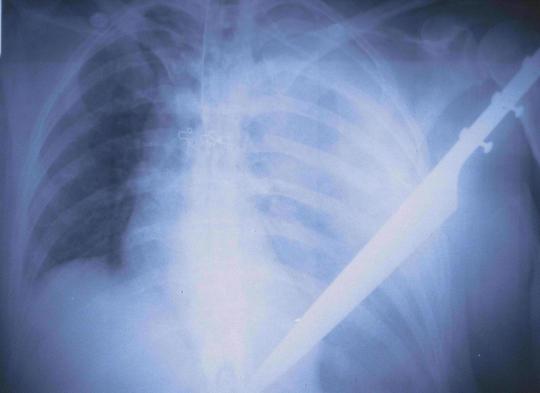Okay, once again here’s the x-ray of an unfortunate trauma patient:

Lets walk through the things I found so you can see how I knew:
- The patient is a female – note the hook and eye clasps in the center of the image.
- She is still on a backboard – there are parallel vertical lucencies on either side of the spine which are the longitudinal wood feet of old fashioned backboards (this image is 20 years old, before plastic was invented, haha)
- She was stabbed with a long, professional cooking knife – apparent from the length and shape of the blade
- The assailant was right handed – the blade was inserted into her left chest
- The course of the knife is left to right, superior to inferior, and anterior to posterior – this is the typical trajectory from a right-handed assailant
- She was unstable, either blood pressure or respirations – the patient has an ET tube, but no IV line yet
- The patient was intubated, most likely due to hypotension and unresponsiveness – same as the last item
- There is a moderate left hemothorax – the hemithorax is not completely opaque, so this is probably in the vicinity of a liter or so.
- The mediastinum is shifted to the right – even though there may be slight rotation of the chest
- A deep sulcus sign is present, either from a pneumothorax that is not easily visible, or from a large hemothorax – the shift and sulcus suggest that there is some tension physiology. Since the hemithorax is not opaque (not a massive amount of blood), there is probably a significant pneumothorax component.
- Intra-abdominal and diaphragmatic injury is almost certain – from the depth and trajectory of the knife. It can’t miss everything!
- A pulmonary contusion is present on the left – note the extra opacity surrounding the knife entry. This is bleeding into the lung parenchyma.
- The stab enters the antero-lateral chest – if it were posterior or more lateral, the patient would be rotated off of it, or the arm would be abducted
- It does not involve the arm or axilla – given the presumed entry into the chest at the base of the handle, it will be too far anterior to involve the arm or axilla
- The patient needs a chest tube now – duh!
- She must be taken to the OR immediately after the tube – double duh!!
Agree or disagree? Tweet or comment below!

